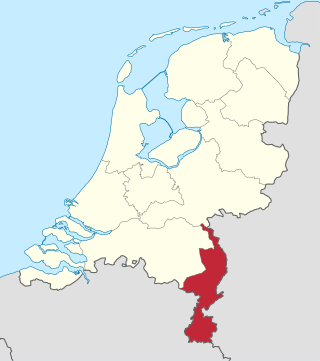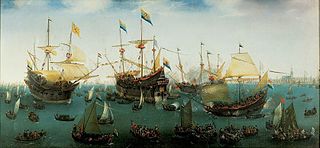
Flanders is the Dutch-speaking northern portion of Belgium and one of the communities, regions and language areas of Belgium. However, there are several overlapping definitions, including ones related to culture, language, politics, and history, and sometimes involving neighbouring countries. The demonym associated with Flanders is Fleming, while the corresponding adjective is Flemish. The official capital of Flanders is the City of Brussels, although the Brussels-Capital Region that includes it has an independent regional government. The powers of the government of Flanders consist, among others, of economic affairs in the Flemish Region and the community aspects of Flanders life in Brussels, such as Flemish culture and education.

Limburg is the southernmost of the twelve provinces of the Netherlands. It is bordered by Gelderland to the north and by North Brabant to its west. Its long eastern boundary forms the international border with the state of North Rhine-Westphalia in Germany. To the west is the international border with the similarly named Belgian province of Limburg, part of which is delineated by the river Meuse. The Vaalserberg is on the extreme southeastern point, marking the tripoint of the Netherlands, Germany and Belgium.

The United Kingdom of the Netherlands is the unofficial name given to the Kingdom of the Netherlands as it existed between 1815 and 1839. The United Netherlands was created in the aftermath of the Napoleonic Wars through the fusion of territories that had belonged to the former Dutch Republic, Austrian Netherlands, and Prince-Bishopric of Liège in order to form a buffer state between the major European powers. The polity was a constitutional monarchy, ruled by William I of the House of Orange-Nassau.

North Brabant, also unofficially called Brabant, is a province in the south of the Netherlands. It borders the provinces of South Holland and Gelderland to the north, Limburg to the east, Zeeland to the west, and the Flemish provinces of Antwerp and Limburg to the south. The northern border follows the Meuse westward to its mouth in the Hollands Diep strait, part of the Rhine–Meuse–Scheldt delta. North Brabant has a population of 2,562,566 as of November 2019. Major cities in North Brabant are Eindhoven, Tilburg, Breda, its provincial capital 's-Hertogenbosch, and Helmond

Antwerp Province, between 1815 and 1830 known as Central Brabant, is the northernmost province both of the Flemish Region, also called Flanders, and of Belgium. It borders on the North Brabant province of the Netherlands to the north and the Belgian provinces of Limburg, Flemish Brabant and East Flanders. Its capital is Antwerp, which includes the Port of Antwerp, the second-largest seaport in Europe. It has an area of 2,876 km2 (1,110 sq mi), and with over 1.85 million inhabitants as of January 2019, is the country's most populous province. The province consists of three arrondissements: Antwerp, Mechelen and Turnhout. The eastern part of the province comprises the main part of the Campine region.

Venray or Venraij is a municipality and a city in Limburg, the Netherlands.

Hasselt is a Belgian city and municipality, and capital and largest city of the province of Limburg in the Flemish Region of Belgium. It is known for its former branding as "the city of taste", as well as its local distilleries of Hasselt jenever (gin), the Hasselt Jenever Festivities, Limburgish pie and the Hasselt speculaas. The municipality includes the original city of Hasselt, plus the boroughs of Sint-Lambrechts-Herk, Wimmertingen, Kermt, Spalbeek, Kuringen, Stokrooie, Stevoort and Runkst, as well as the hamlets and parishes of Kiewit, Godsheide and Rapertingen.

Coal mining in Limburg, a province of the Netherlands, has taken place since the 16th century.

The Ostend Company, officially the General Company Established in the Austrian Netherlands for Commerce and Navigation in the Indies was a chartered trading company in the Austrian Netherlands in the Holy Roman Empire which was established in 1722 to trade with the East and West Indies. It took its name from the Flemish port city of Ostend.

The Campine or De Kempen is a natural region situated chiefly in north-eastern Belgium and parts of the south-eastern Netherlands which once consisted mainly of extensive moors, tracts of sandy heath, and wetlands. It encompasses a large northern and eastern portion of Antwerp Province and adjacent parts of Limburg in Belgium, as well as portions of the Dutch province of North Brabant and Dutch Limburg around Weert.

The Battle of Overloon was a battle fought in the Second World War battle between Allied forces and the German Army which took place in and around the village of Overloon in the south-east of the Netherlands between 30 September and 18 October 1944. The battle, which resulted in an Allied victory, ensued after the Allies launched Operation Aintree. The Allies went on to liberate the town of Venray.

Well is a village of about 2500 residents in the municipality of Bergen in the province of Limburg in the southeastern part of the Netherlands. The town is located between Nijmegen and Venlo, it's east to the town of Venray. The village of Well can be reached via public transport by using bus line 83 or 81.

Wanssum is a village in the Dutch province of Limburg. It is located in the municipality of Venray.

The Amsterdam Entrepôt is the shorthand term that English-language economic historiographers use to refer to the trade system that helped the Dutch Republic achieve primacy in world trade during the 17th century. The Dutch prefer the term stapelmarkt, which has less currency in the English language.
The development of urban centres in the Low Countries shows the process by which the Low Countries, a region in Western Europe, evolved from a highly rural outpost of the Roman Empire into the largest urbanised area north of the Alps by the 15th century CE. As such, this article covers the development of Dutch and Flemish cities beginning at the end of the migration period till the end of the Dutch Golden Age.

Antwerp is the largest city in Belgium by area at 204.51 km2 (78.96 sq mi) and the capital of Antwerp Province in the Flemish Region. With a population of 536,079, it is the most populous municipality in Belgium, and with a metropolitan population of around 1,200,000 people, it is the second-largest metropolitan region in Belgium, second only to Brussels.

Major Kenneth George Mayhew was a British Army veteran of the Second World War. Mayhew was one of the recipients of the Military William Order, the highest honour of the Kingdom of the Netherlands.

Raceway Venray, formerly known as Circuit de Peel, is a motorsport racing circuit in Venray, Netherlands. The track consists of a banked half mile oval with a flat quarter mile oval inside and features a karting track using portions of both along with dedicated sections. The track host its own local championships, national championships in cooperation with the Midland Circuit in Lelystad and Circuit de Polderputten in Ter Apel.

The Compagnie van De Moucheron was a pre-company and precursor of the Verenigde Oost Indische Compagnie, from the Republic of the Seven United Netherlands. It was founded by Balthazar de Moucheron, a ship owner from Antwerp in the Southern Netherlands. After the fall of Antwerp he moved his business to Zeeland. The fleet of the Compagnie van De Moucheron was made up of three ships, 'Ram', 'Schaap' (Sheep) and the pinasse 'Lam' (Lamb) and was headed by Joris van Spilbergen. Its fleet left on 5 May 1601 and returned to the Republic of the Seven United Netherlands in 1604.

Land van Cuijk is a municipality in the province of North Brabant, Netherlands, formed from the merger of Boxmeer, Cuijk, Sint Anthonis, Mill en Sint Hubert and Grave. The municipality came into existence on 1 January 2022. It belongs to the region of De Peel.


















